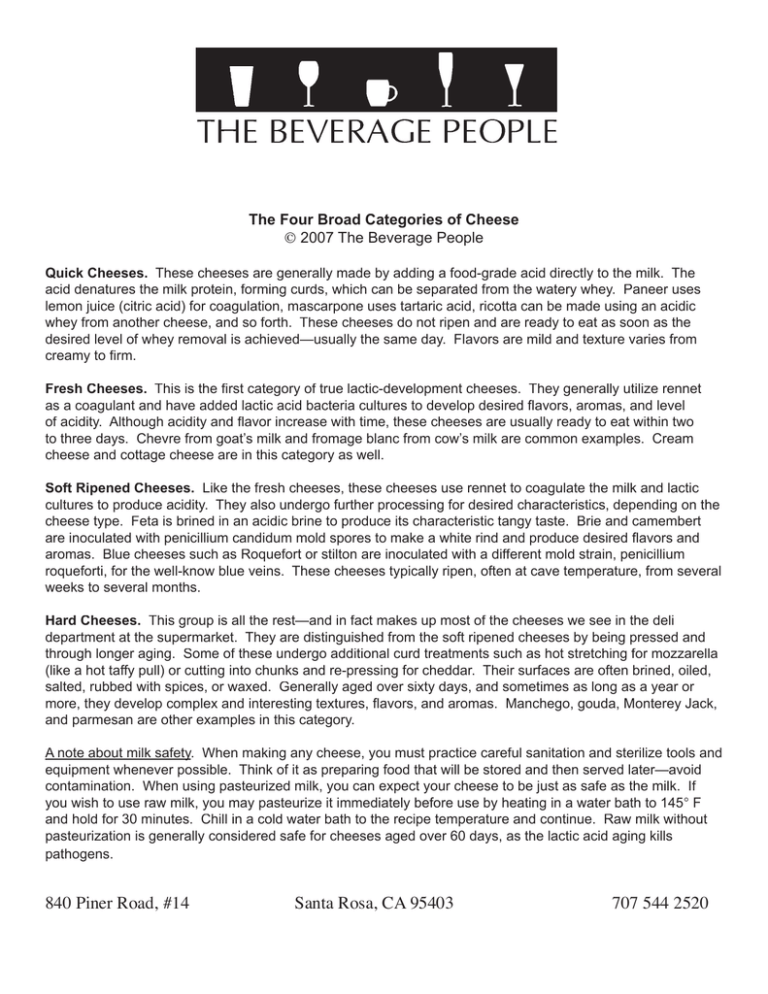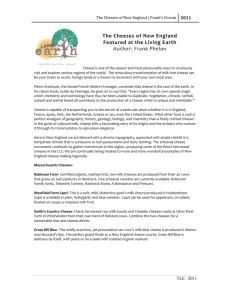The Four Broad Categories of Cheese
advertisement

The Four Broad Categories of Cheese 2007 The Beverage People Quick Cheeses. These cheeses are generally made by adding a food-grade acid directly to the milk. The acid denatures the milk protein, forming curds, which can be separated from the watery whey. Paneer uses lemon juice (citric acid) for coagulation, mascarpone uses tartaric acid, ricotta can be made using an acidic whey from another cheese, and so forth. These cheeses do not ripen and are ready to eat as soon as the desired level of whey removal is achieved—usually the same day. Flavors are mild and texture varies from creamy to firm. Fresh Cheeses. This is the first category of true lactic-development cheeses. They generally utilize rennet as a coagulant and have added lactic acid bacteria cultures to develop desired flavors, aromas, and level of acidity. Although acidity and flavor increase with time, these cheeses are usually ready to eat within two to three days. Chevre from goat’s milk and fromage blanc from cow’s milk are common examples. Cream cheese and cottage cheese are in this category as well. Soft Ripened Cheeses. Like the fresh cheeses, these cheeses use rennet to coagulate the milk and lactic cultures to produce acidity. They also undergo further processing for desired characteristics, depending on the cheese type. Feta is brined in an acidic brine to produce its characteristic tangy taste. Brie and camembert are inoculated with penicillium candidum mold spores to make a white rind and produce desired flavors and aromas. Blue cheeses such as Roquefort or stilton are inoculated with a different mold strain, penicillium roqueforti, for the well-know blue veins. These cheeses typically ripen, often at cave temperature, from several weeks to several months. Hard Cheeses. This group is all the rest—and in fact makes up most of the cheeses we see in the deli department at the supermarket. They are distinguished from the soft ripened cheeses by being pressed and through longer aging. Some of these undergo additional curd treatments such as hot stretching for mozzarella (like a hot taffy pull) or cutting into chunks and re-pressing for cheddar. Their surfaces are often brined, oiled, salted, rubbed with spices, or waxed. Generally aged over sixty days, and sometimes as long as a year or more, they develop complex and interesting textures, flavors, and aromas. Manchego, gouda, Monterey Jack, and parmesan are other examples in this category. A note about milk safety. safety When making any cheese, you must practice careful sanitation and sterilize tools and equipment whenever possible. Think of it as preparing food that will be stored and then served later—avoid contamination. When using pasteurized milk, you can expect your cheese to be just as safe as the milk. If you wish to use raw milk, you may pasteurize it immediately before use by heating in a water bath to 145° F and hold for 30 minutes. Chill in a cold water bath to the recipe temperature and continue. Raw milk without pasteurization is generally considered safe for cheeses aged over 60 days, as the lactic acid aging kills pathogens. 840 Piner Road, #14 Santa Rosa, CA 95403 707 544 2520

